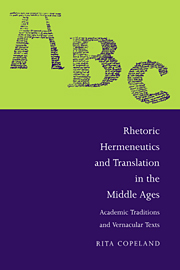Book contents
- Frontmatter
- Contents
- Acknowledgments
- List of abbreviations
- Introduction
- 1 Roman theories of translation: the fusion of grammar and rhetoric
- 2 From antiquity to the Middle Ages I: the place of translation and the value of hermeneutics
- 3 The rhetorical character of academic commentary
- 4 Translation and interlingual commentary: Notker of St. Gall and the Ovide moralisé
- 5 Translation and intralingual reception: French and English traditions of Boethius' Consolatio
- 6 From antiquity to the Middle Ages II: rhetorical invention as hermeneutical performance
- 7 Translation as rhetorical invention: Chaucer and Gower
- Afterword
- Notes
- Bibliography
- 1 Index of names and titles
- 2 General index
1 - Roman theories of translation: the fusion of grammar and rhetoric
Published online by Cambridge University Press: 03 December 2009
- Frontmatter
- Contents
- Acknowledgments
- List of abbreviations
- Introduction
- 1 Roman theories of translation: the fusion of grammar and rhetoric
- 2 From antiquity to the Middle Ages I: the place of translation and the value of hermeneutics
- 3 The rhetorical character of academic commentary
- 4 Translation and interlingual commentary: Notker of St. Gall and the Ovide moralisé
- 5 Translation and intralingual reception: French and English traditions of Boethius' Consolatio
- 6 From antiquity to the Middle Ages II: rhetorical invention as hermeneutical performance
- 7 Translation as rhetorical invention: Chaucer and Gower
- Afterword
- Notes
- Bibliography
- 1 Index of names and titles
- 2 General index
Summary
The Middle Ages inherited from Latin antiquity not only some commonplaces of translation theory, but also the academic framework for that theory. Roman theories of translation represented only one aspect of a much larger debate, within academic and critical circles, about the relationship between the study of grammar and the study of rhetoric. The familiar precepts about translation, which the Middle Ages borrowed from antiquity, center on the idea that translation may be literal (word for word) or loose (sense for sense); we find variations on this standard theme throughout medieval translators' prologues. But it is not by tracing the fortunes of these commonplaces that we can evaluate the theoretical conditions under which ideas about translation were mediated from antiquity to the Middle Ages. In Latin antiquity, it was the framework of rhetoric and grammar, and of the relationship between these two disciplines, that gave meaning to ideas about translation. For the Middle Ages as well, it was through the tradition of academic discourse, inherited from the Romans, that ideas about translation took shape. In both antiquity and the Middle Ages, these systems of academic discourse had profound implications for the organization of textual culture as a whole. By examining the changing role of translation within these academic systems we can gain insight into the historical redefinitions of the systems themselves. Thus we begin here with the earliest formulations of these problems in antiquity.
In both Greek and Roman schools, the discipline of grammar comprised not only the technical study of language, but also textual commentary or criticism, the ancestor of what we today would call literary criticism.
- Type
- Chapter
- Information
- Rhetoric, Hermeneutics, and Translation in the Middle AgesAcademic Traditions and Vernacular Texts, pp. 9 - 36Publisher: Cambridge University PressPrint publication year: 1991



